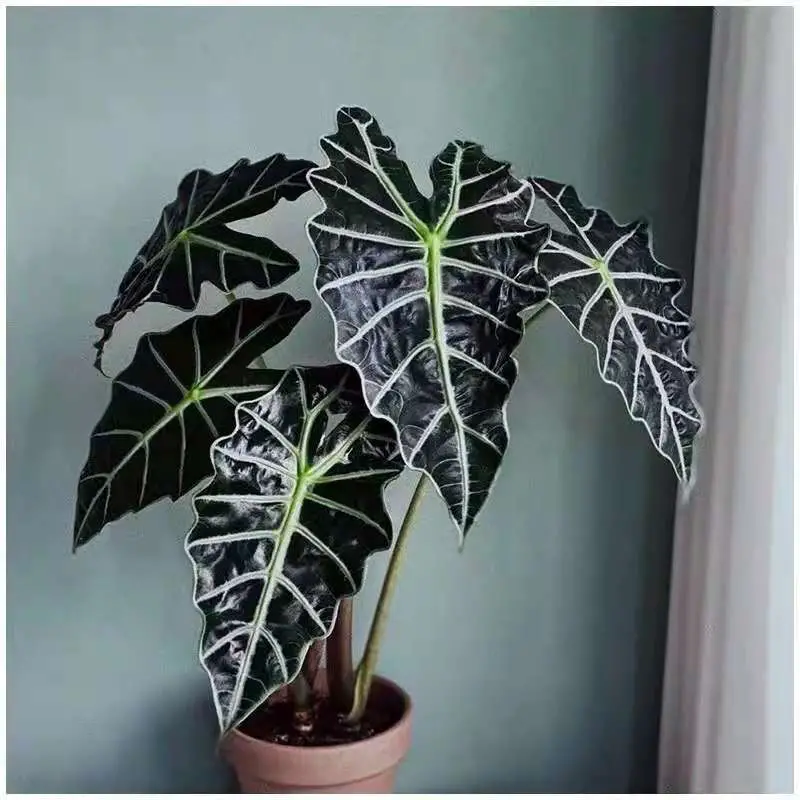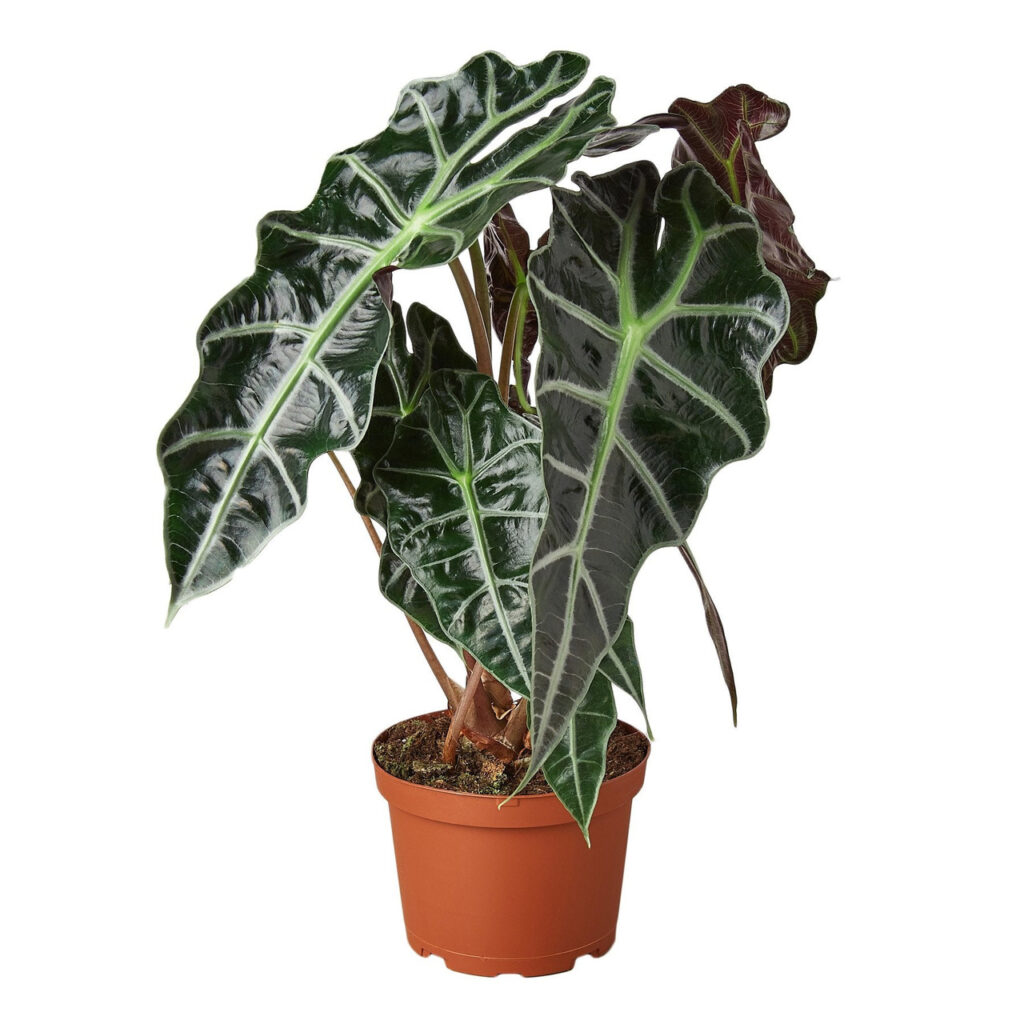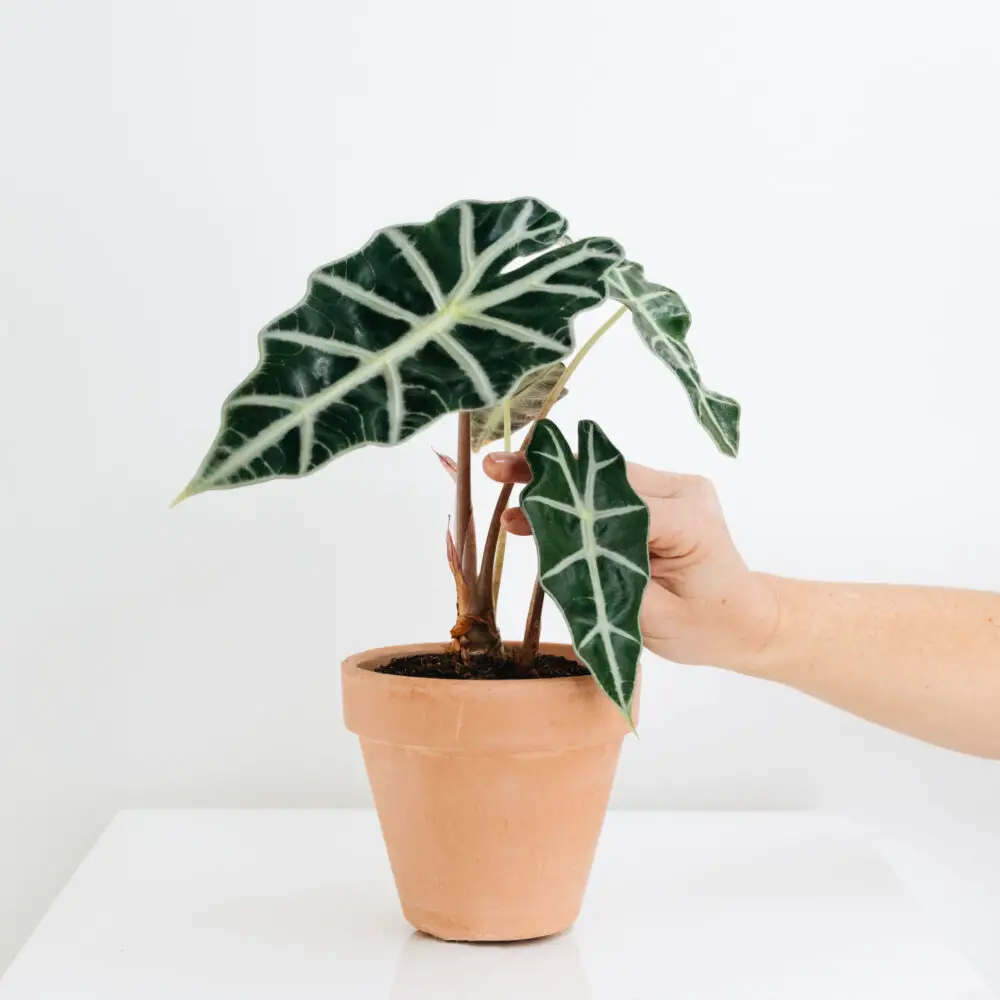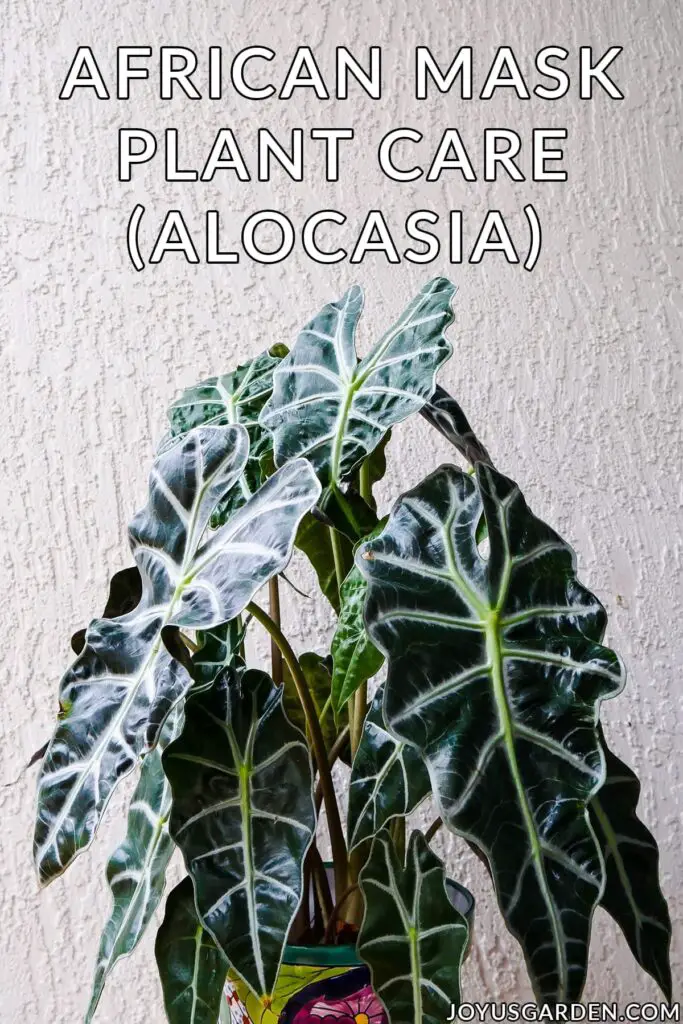The African Mask Alocasia plant, known for its striking foliage, thrives with proper care. Provide bright, indirect light, maintain humidity, and ensure well-draining soil. Water regularly but avoid overwatering to prevent root rot. With these simple guidelines, your Alocasia can flourish indoors or outdoors.
Understanding the African Mask Alocasia
The African Mask Alocasia, scientifically known as Alocasia micholitziana, is a popular houseplant admired for its unique, arrow-shaped leaves and dramatic patterns. This tropical plant is native to Southeast Asia and thrives in warm, humid environments. Its striking appearance makes it a favorite among plant enthusiasts and interior decorators alike.

One of the key features of the African Mask Alocasia is its large, glossy leaves that can grow up to two feet long. The leaves often showcase intricate venation and a deep green color, sometimes with hints of purple on the undersides. This aesthetic appeal contributes to its nickname, as the leaves resemble traditional African masks.
While the African Mask Alocasia can be a stunning addition to any plant collection, it does require specific care to thrive. Understanding its natural habitat helps in recreating the right environment for this plant. In the wild, it typically grows under the canopy of larger trees, receiving filtered sunlight and high humidity levels. Therefore, replicating these conditions is essential when caring for your Alocasia.
Key Care Requirements
To ensure your African Mask Alocasia remains healthy and vibrant, pay close attention to the following care requirements:

| Care Aspect | Requirements |
|---|---|
| Light | Bright, indirect sunlight |
| Temperature | 65°F to 80°F (18°C to 27°C) |
| Humidity | High humidity (60% or more) |
| Watering | Keep soil moist but not soggy |
| Soil | Well-draining potting mix |
Light Requirements
The African Mask Alocasia thrives in bright, indirect sunlight. Direct exposure to harsh sunlight can scorch its leaves. A spot near a window with filtered light works best. If you notice the leaves stretching towards the light source, it may indicate that the plant needs more light.
Temperature and Humidity
This plant prefers a warm climate, ideally between 65°F and 80°F. It is sensitive to cold drafts or sudden temperature changes. Keeping it away from windows during winter months can help maintain a stable environment.
Humidity is crucial for the African Mask Alocasia. Ideally, humidity levels should be at least 60%. You can increase humidity by misting the leaves regularly or placing a humidifier nearby. Alternatively, placing the pot on a tray filled with water and pebbles can also help maintain moisture levels in the air around the plant.

Watering and Soil Conditions
Water your African Mask Alocasia when the top inch of soil feels dry. It is essential to keep the soil consistently moist but not overly saturated. Overwatering can lead to root rot, which can be detrimental to the plant’s health. Using a well-draining potting mix is vital for preventing water accumulation around the roots.
With these care tips in mind, your African Mask Alocasia can thrive and become a focal point in your home or garden. Proper attention to light, temperature, humidity, watering, and soil will lead to a healthy, beautiful plant that brings life to any space.
Pest and Disease Management
Despite its beauty, the African Mask Alocasia can be susceptible to various pests and diseases. Being proactive about pest management is essential for keeping your plant healthy. Here are some common pests and diseases that may affect your Alocasia, along with prevention and treatment options:
- Spider Mites: These tiny pests thrive in low humidity and can cause yellowing leaves. To manage spider mites, increase humidity and regularly mist the plant. If an infestation occurs, use insecticidal soap or neem oil.
- Scale Insects: Scale can appear as small, brown bumps on the stems and leaves. They can be removed by gently scraping them off with a soft cloth or using a cotton swab dipped in alcohol.
- Mealybugs: These pests resemble small cotton balls and can weaken the plant. Spray the affected areas with insecticidal soap or neem oil to eliminate them.
- Root Rot: This disease is often caused by overwatering. Ensure your pot has drainage holes, and allow the topsoil to dry out between waterings. If root rot occurs, remove the plant from the pot, trim away the affected roots, and repot in fresh soil.
Fertilizing Your African Mask Alocasia
Proper fertilization is crucial for the growth and vitality of your African Mask Alocasia. During the growing season, which typically spans from spring to early fall, feeding your plant can yield impressive results. Here are some guidelines for fertilizing:

- Type of Fertilizer: Use a balanced liquid fertilizer diluted to half strength. A fertilizer with an N-P-K ratio of 10-10-10 is a good option.
- Frequency: Fertilize every four to six weeks during the growing season. Reduce feeding during the winter months when the plant’s growth slows.
- Application: Apply fertilizer to damp soil to prevent root burn. Avoid getting fertilizer on the leaves.
Repotting Your Plant
Repotting is an essential aspect of maintaining your African Mask Alocasia’s health. As the plant grows, it may outgrow its current pot, leading to root binding. Here are some tips for repotting:
- Timing: Repot your Alocasia every 1-2 years or when you notice roots emerging from the drainage holes.
- Choosing a New Pot: Select a pot that is one size larger than the current one and has drainage holes.
- Soil Mix: Use a well-draining potting mix suitable for tropical plants. You can create your mix by combining potting soil with perlite or orchid bark.
- Transplanting: Gently remove the plant from its current pot. Take care not to damage the roots. Place it in the new pot and fill with soil, ensuring the root ball is level with the top of the pot.
Propagation Techniques
If you want to expand your collection or share your African Mask Alocasia with friends, propagation is a rewarding option. Here are some methods to propagate this stunning plant:
- Division: This is the most common method. During repotting, carefully separate offsets from the main plant. Ensure each offset has roots and at least one leaf. Plant them in their pots with suitable soil.
- Offsets: Sometimes, your Alocasia will produce smaller plants at its base. These can be cut off and potted separately.
- Leaf Cuttings: Although less common for Alocasia, you can try taking a leaf cutting with a portion of the petiole (the leaf stem). Place it in water until roots develop before transferring it to soil.
Common Myths About African Mask Alocasia
A
s popular as the African Mask Alocasia is, several myths surround its care. Understanding these misconceptions can help you provide better care for your plant:
- Myth 1: Alocasia plants are poisonous only to pets. In reality, they can be toxic to both pets and humans if ingested.
- Myth 2: Alocasia does not need humidity. This plant thrives in high humidity levels, making it essential for its health.
- Myth 3: All Alocasias are similar in care requirements. Different species have varying needs, so it’s important to research specific care tips for each type.
By debunking these myths and understanding proper care techniques, you can ensure your African Mask Alocasia remains healthy and vibrant for years to come.
Seasonal Care Tips
The care requirements for your African Mask Alocasia can change with the seasons. Understanding these seasonal variations is essential for maintaining a healthy plant throughout the year. Here are some tips for each season:
Spring
Spring marks the beginning of the growing season for many plants, including the African Mask Alocasia. During this time, you should:
- Increase Watering: As temperatures rise, the plant will require more frequent watering. Check the soil moisture regularly.
- Begin Fertilizing: Start fertilizing your Alocasia every four to six weeks with a balanced liquid fertilizer to support new growth.
- Repot if Necessary: If your plant has outgrown its pot or shows signs of root binding, spring is the ideal time to repot.
Summer
Summer brings warmth and longer days, which can encourage rapid growth. In summer, focus on:
- Maintaining Humidity: Ensure humidity levels remain high to support the plant’s growth. Consider using a humidifier or pebble tray if necessary.
- Monitoring for Pests: Keep an eye out for pests that thrive in warm weather, such as spider mites and mealybugs.
- Watering Consistently: Continue checking soil moisture regularly. The plant may need more water during hot spells.
Fall
As temperatures begin to cool in the fall, your African Mask Alocasia may slow its growth. Adjust care as follows:
- Reduce Fertilizing: Cut back on fertilization as the plant enters dormancy. Fertilize only if there’s significant new growth.
- Adjust Watering: Water less frequently, allowing the top inch of soil to dry out before each watering.
- Prepare for Winter: Consider moving your plant indoors if it is typically kept outside, as temperatures drop.
Winter
Winter can be challenging for tropical plants like the African Mask Alocasia. During this season, prioritize:
- Maintaining Warmth: Keep your plant in a warm location away from cold drafts and windows where temperatures can drop significantly.
- Lowering Watering Frequency: Since growth slows down, reduce watering to prevent overwatering and root rot. Water only when the soil is completely dry.
- Increased Light Exposure: Ensure the plant receives enough light during shorter days. Consider using grow lights if natural light is insufficient.
Caring for Leaves
The leaves of the African Mask Alocasia are one of its most striking features. Proper leaf care not only enhances its appearance but also promotes overall plant health. Here are some tips for caring for your plant’s leaves:
- Dusting: Regularly wipe the leaves with a damp cloth to remove dust. This helps improve photosynthesis and keeps the plant looking its best.
- Misting: Misting the leaves can help increase humidity around the plant. However, avoid excessive moisture that can lead to fungal issues.
- Pruning Dead Leaves: Trim off any yellow or dead leaves to encourage new growth and maintain the plant’s appearance.
Environmental Considerations
The
African Mask Alocasia is sensitive to its environment. By creating an ideal setting, you can enhance its growth and overall well-being. Here are some environmental considerations to keep in mind:
- Air Circulation: Ensure good air circulation around the plant to prevent fungal diseases. Avoid placing it in overly crowded spaces.
- Avoid Sudden Changes: Be cautious of sudden temperature changes or drafts that can stress the plant. Gradually acclimate your Alocasia if moving it to a new location.
- Choose the Right Container: Use pots with drainage holes to allow excess water to escape, preventing waterlogged soil.
Aesthetic Placement
The African Mask Alocasia’s dramatic foliage makes it a perfect focal point in any room or garden. When choosing a placement, consider the following factors:
- Lighting Conditions: Place your Alocasia in an area that receives bright, indirect light. A spot near a north or east-facing window is often ideal.
- Complementary Decor: Position the plant where its striking leaves can contrast or complement your existing decor. It pairs well with natural materials like wood and stone.
- Group with Other Plants: Consider grouping your Alocasia with other houseplants that have similar care needs to create a lush indoor garden feel.
Caring for your African Mask Alocasia requires attention to detail and an understanding of its unique needs throughout each season. By following these guidelines, you can cultivate a flourishing and vibrant plant that enhances any space.
Additional Tips for Success
To
ensure the best care for your African Mask Alocasia, consider these additional tips that can help enhance its growth and vitality:
- Regular Observation: Take time to observe your plant regularly. Look for signs of distress such as yellowing leaves, drooping, or pest infestations. Early detection can prevent more significant issues.
- Rotate Your Plant: To promote even growth, rotate your Alocasia every few weeks. This practice ensures all sides receive adequate light exposure, preventing the plant from leaning towards the light source.
- Seasonal Clean-Up: In addition to dusting the leaves, consider removing any dead foliage or debris around the base of the plant. This practice helps prevent pests and diseases from taking hold.
- Be Patient: Like many houseplants, the African Mask Alocasia may take time to acclimate to a new environment. Be patient with its growth and avoid the temptation to over-care.
- Research Varieties: Familiarize yourself with different Alocasia varieties, as each may have unique needs and care requirements. Understanding these differences can enhance your gardening experience.
Final Thoughts
The African Mask Alocasia is a stunning and exotic addition to any indoor or outdoor space. Its dramatic foliage and unique appearance make it a favorite among plant enthusiasts. By following the care guidelines outlined in this guide, you can create an environment where your Alocasia thrives.
Remember that successful plant care is a combination of knowledge, attention, and adaptability. Each plant is unique, and understanding its specific needs and responding accordingly will lead to a healthier and more vibrant specimen. Pay close attention to factors such as light, humidity, watering, and pest management to maximize the potential of your African Mask Alocasia.
With dedication and proper care, your African Mask Alocasia will not only survive but flourish, becoming a striking centerpiece in your home or garden. Whether you are a seasoned plant parent or a beginner looking to expand your collection, this guide aims to empower you with the knowledge needed to cultivate this beautiful plant successfully.
Embrace the journey of nurturing your African Mask Alocasia, and enjoy the beauty it brings to your life. Happy planting!
